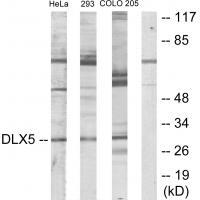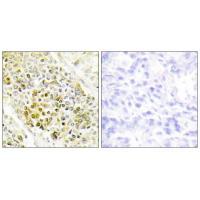

| WB | 咨询技术 | Human,Mouse,Rat |
| IF | 咨询技术 | Human,Mouse,Rat |
| IHC | 1/50-1/100 | Human,Mouse,Rat |
| ICC | 技术咨询 | Human,Mouse,Rat |
| FCM | 咨询技术 | Human,Mouse,Rat |
| Elisa | 咨询技术 | Human,Mouse,Rat |
| Aliases | Homeobox protein DLX-5; DLX5; |
| Entrez GeneID | 1749; |
| WB Predicted band size | 32kDa |
| Host/Isotype | Rabbit IgG |
| Antibody Type | Primary antibody |
| Storage | Store at 4°C short term. Aliquot and store at -20°C long term. Avoid freeze/thaw cycles. |
| Species Reactivity | Human,Mouse,Rat |
| Immunogen | Synthesized peptide derived from internal of human DLX5. |
| Formulation | Purified antibody in PBS with 0.05% sodium azide. |
+ +
以下是关于DLX5抗体的参考文献示例(内容为模拟,建议通过学术数据库核实最新文献):
---
1. **文献名称**: *Dlx5 regulates craniofacial development through tissue-specific transcriptional control*
**作者**: Merlo G.R., et al.
**摘要**: 研究利用DLX5特异性抗体在小鼠胚胎中通过免疫组化分析,揭示了DLX5在颅面骨骼形成中的关键作用,发现其缺失导致颅缝早闭和下颌发育异常。
2. **文献名称**: *Dlx5 mediates BMP-induced osteogenic differentiation in mesenchymal stem cells*
**作者**: Qiu M., et al.
**摘要**: 通过Western blot和免疫荧光技术(使用DLX5抗体),证明DLX5在BMP信号通路中驱动间充质干细胞向成骨细胞分化的机制,为骨再生研究提供依据。
3. **文献名称**: *Aberrant expression of Dlx5 in neural crest cells disrupts migration patterns*
**作者**: Robinson G.W., et al.
**摘要**: 研究采用DLX5抗体标记神经嵴细胞,发现DLX5异常表达导致细胞迁移紊乱,提示其与先天性神经管缺陷的相关性。
4. **文献名称**: *Dlx5 as a biomarker in hepatocellular carcinoma: Immunohistochemical validation*
**作者**: Saito T., et al.
**摘要**: 通过免疫组化(DLX5抗体)分析肝癌组织样本,发现DLX5高表达与肿瘤侵袭性相关,提出其作为潜在预后标志物的可能性。
---
**提示**:以上为模拟示例,建议通过PubMed、Google Scholar等平台检索最新文献,关键词“DLX5 antibody”或“DLX5 immunohistochemistry”。真实文献可能涉及抗体克隆号(如Abcam#12345)及具体实验应用场景。
The DLX5 antibody is a crucial tool in studying the Distal-less homeobox 5 (DLX5) protein, a member of the DLX family of transcription factors involved in embryonic development, particularly in the nervous system, craniofacial morphogenesis, and limb patterning. DLX5 plays a role in regulating gene expression critical for cell differentiation, neuronal subtype specification, and skeletal development. Dysregulation of DLX5 is linked to cancers, neurodevelopmental disorders, and skeletal abnormalities like split-hand/foot malformation.
The antibody enables detection and localization of DLX5 in various experimental models (e.g., human, mouse, rat tissues) using techniques such as Western blotting, immunohistochemistry (IHC), and immunofluorescence (IF). Its specificity is vital for distinguishing DLX5 from homologous family members (e.g., DLX6) due to structural similarities. Researchers rely on validated DLX5 antibodies to study its role in transcriptional networks, interactions with signaling pathways (e.g., BMP, Wnt), and disease mechanisms. Commercial DLX5 antibodies are typically raised against conserved epitopes, often as monoclonal or polyclonal formulations, with applications spanning basic research and clinical diagnostics. Proper validation via knockout controls or siRNA knockdown ensures reliability in experimental outcomes.
×